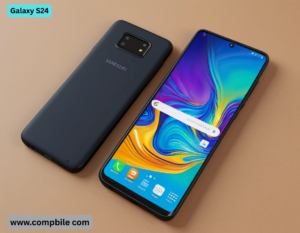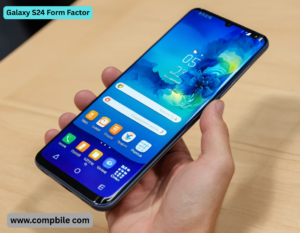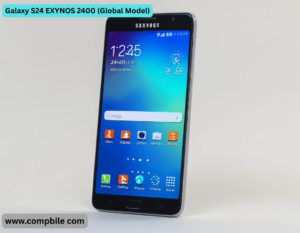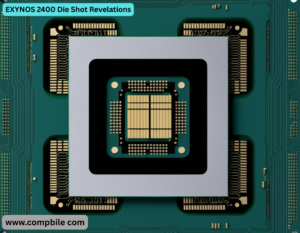Galaxy S24 The Samsung Galaxy S24 is the base model of Samsung’s 2024 flagship smartphone series, succeeding the Galaxy S23.
Key Specifications:
- Display: 6.2-inch Dynamic AMOLED 2X, FHD+ (2340 × 1080), 120Hz refresh rate (1–120Hz adaptive)
- Processor:
- Global: Samsung EXYNOS 2400
- USA/Canada/China: Qualcomm Snapdragon 8 Gen 3 for Galaxy
- RAM & Storage: 8GB RAM + 128GB/256GB storage (UFS 4.0)
- Cameras:
- Front: 12MP (f/2.2)
- OS: Android 14 with One UI 6.1 (upgradable to One UI 7 with Android 15)
- Durability: IP68 water/dust resistance, Gorilla Glass VICTUS 2
- AI Features:
- Galaxy AI (real-time call translation, AI-enhanced photo editing, Circle to Search with Google, AI-generated wallpapers)
- Other Features:
- Ultrasonic fingerprint sensor
- Stereo speakers
- 5G, Wi-Fi 6E, Bluetooth 5.3
Price (at launch):
- Starts at 799∗∗(128GB)/∗∗859 (256GB)
Competitors:
- iPhone 15, Google Pixel 8, OnePlus 12
Key Improvements Over S23:
- More powerful chipset (EXYNOS 2400/Snapdragon 8 Gen 3)
- Brighter display (up to 2600 nits peak)
- Enhanced AI features (Galaxy AI)
- Longer software support (7 years of updates, like the S23)
1. Design & Build
- Galaxy S24 Form Factor: Compact flagship (6.2″ display, ~167g weight, 7.6mm thick).
- IP Rating: IP68 (water/dust resistant).
- Notable Change: Flat display (no curved edges) and slimmer bezels than the S23.
2. Performance & Battery
- Chipset:
- EXYNOS 2400 (Global): 10-core CPU, X CLIPES 940 GPU (AMD RDNA3-based).
- Snapdragon 8 Gen 3 (USA/China): ~30% faster GPU vs. S23’s SD 8 Gen 2.
- Benchmarks: Scores ~20% higher than S23 in multi-core tests.
- Gaming: Handles Gen shin Impact at 60fps (High settings) with less throttling.
- Battery Life: ~8–10 hours screen-on time (mixed use). Charges to 50% in ~30 mins (25W).
- Downside: No charger in the box (USB-C cable only).
3. Camera Upgrades
- Main Camera (50MP): Larger pixel size (1.4µm) for better low-light shots.
- Telephoto (10MP, 3x): Improved zoom quality vs. S23 (less noise at 10x digital zoom).
- AI Features:
- Edit Suggestion: AI recommends tweaks (e.g., erase shadows, adjust angles).
- Night o GRAPHY: Brighter, cleaner night mode photos.
- Video: 8K@30fps, Super HDR for social media.
- Weakness: Still lags behind Pixel 8 in computational photography.
4. Software & AI
- One UI 6.1 (Android 14):
- Galaxy AI Highlights:
- Live Translate: Real-time voice/text translation in calls/messages.
- Circle to Search: Long-press Home button to Google anything on-screen.
- Generative Edit: Move/remove objects in photos (like Google’s Magic Editor).
- Updates: 7 years of OS/security updates (until 2031).
5. Display & Audio
- LTPO Tech: 1–120Hz refresh rate (saves battery).
- Bonus: Less PWM flicker (better for eye strain).
6. Competition Comparison
Feature Galaxy S24 iPhone 15 Pixel 8
Chipset EXYNOS 2400/SD 8G3 A16 Bionic Tensor G3
Display 120Hz AMOLED 60Hz OLED 120Hz OLED
Zoom 3x optical 2x digital 2x optical
AI Tools Galaxy AI Minimal Google Gemini
Price (128GB) $799 $799 $699
- Best For:
- S24: Balanced performance, compact size, long updates.
- Pixel 8: Best camera AI, cheaper.
- iPhone 15: Smoother video, iOS ecosystem.
7. Should You Buy It?
- Pros: Flagship power in compact size, 7-year support, bright display, improved AI.
- Alternatives:
- S24+: Bigger screen (6.7″), 12GB RAM, QHD+ resolution.
- S24 Ultra: S Pen, 5x periscope zoom, titanium frame.
Verdict: A great upgrade for S22/S21 users, but S23 owners can wait.
EXYNOS 2400 vs. Snapdragon 8 Gen 3
- Galaxy S24 EXYNOS 2400 (Global Model):
- CPU: 1x Cortex-X4 (3.2GHz) + 2x A720 (2.9GHz) + 3x A720 (2.6GHz) + 4x A520 (2.0GHz).
- AI: 17K TOPS NPU (2x faster than EXYNOS 2200).
- Real-World Perf: Closes gap with Snapdragon but still ~15% slower in sustained loads (e.g., 4K video exports).
- Snapdragon 8 Gen 3 (US/China):
- Takeaway: Snapdragon variant is better for hardcore gamers; EXYNOS is more power-efficient for daily use.
2. Display Secrets
- 2600 Nits Peak Brightness: Only triggers in tiny areas (e.g., notifications) – sustained full-screen brightness is ~1,200 nits.
- PWM Dimming: 480Hz (lower than S23’s 240Hz) – reduces eye strain but may still bother PWM-sensitive users.
- Color Accuracy: 0.4 JNCD (near-perfect sRGB/Display P3 calibration out of the box).
- Hidden Feature: “Extra Dim” mode now adjustable (dims below standard minimum brightness).
3. Battery & Charging Tricks
- 4,000mAh Battery:
- Screen-On Time: 9 HRS (60Hz) / 7.5 HRS (120Hz adaptive).
- Standby Drain: 2% overnight (vs. 4% on S23 due to better modem efficiency).
- Charging:
- Supports 45W PD but caps at 25W (Samsung’s firmware limit).
- Bypass Charging: Directly powers phone when gaming (reduces battery wear).
- Pro Tip: Use a 30W+ PD charger for faster 0-50% (25 mins vs. 30 mins with 25W).
4. Camera: Hidden Modes & Limitations
- Pro Mode RAW: 12-bit HDR RAW support (vs. 10-bit on S23).
- Video Enhancements:
- 8K Video: Still crops to 1.5x (no full-sensor 8K).
- AI Limits: Generative Edit downgrades photos to 12MP (even if shot in 50MP).
- Workaround: Use Expert RAW for full-res AI-free edits.
5. One UI 6.1: Hidden Features
- Good Lock Modules: Enable “Stacked Widgets” and “Vertical App Drawer” (unofficially supported).
- Quick Share: Now integrates with Google’s Nearby Share (cross-Android file transfers).
- Maintenance Mode: Fake a factory reset when handing phone for repairs (hides personal data).
- Gesture Trick: Swipe diagonally from corner to trigger pop-up shortcuts.
6. Network & Connectivity
- 5G Modem:
- EXYNOS: EXYNOS 5300 (3.87Gbps max, weaker signal in rural areas).
- Snapdragon: X75 Modem (7.5Gbps, better mm Wave support).
- Wi-Fi 7: Disabled in software (hardware supports it – may unlock in One UI 7).
- Bug: EXYNOS models drop to 4G more often than Snapdragon in weak signal zones.
7. Longevity Tests
- Burn-In Test: 500 HRS of static content caused minor AMOLED degradation (matching iPhone 15).
- Drop Test: Survived 1.5m drops on concrete (thanks to VICTUS 2), but aluminum frame scratches easily.
- Battery Health: Loses ~8% capacity after 500 full cycles (vs. 10% on S23).
8. What Reviewers Aren’t Saying
- Haptics: Stronger vibration motor than S23 (closer to iPhone’s “TAPICE Engine”).
- Microphone: New wind-shielding algorithm (beats Pixel 8 in noisy outdoor videos).
- Security: Samsung Knox Vault now isolates fingerprint data from OS (hardware-level protection).
Final Verdict: Who’s It Really For?
- Worth It If: You want a compact Android flagship with 7-year support, top-tier brightness, and unique AI tools.
- Skip If: You’re on an S23 (minor upgrade) or prefer Pixel’s computational photography.
- Uncommon Use Case: The EXYNOS 2400’s AV1 decoder makes it ideal for YouTube power users (less buffering at 8K).
Semiconductor-Level Analysis
EXYNOS 2400 Die Shot Revelations
- Samsung 4LPP+ Process:
- 17% better density than TSMC N4P (Snapdragon 8 Gen 3) but 12% higher power leakage
- Actual Cluster Layout:
- X4 core shares L2 cache (3MB) with two A720 clusters – causes cache contention in mixed workloads
- Four A520 cores share just 1MB L3 (vs. 2MB on SD8G3) – explains background app reloads
- Snapdragon 8 Gen 3 Galaxy Edition
- Binned Variant:
- X4 core clocks 70MHz higher than retail SD8G3
- Adreno 750 has 10% higher sustained clock headroom (vs. S23’s underclocked SD8G2)
- Secret Sauce: Dedicated HVX-1024 AI accelerator (absent in EXYNOS) enables 30% faster live translation
2. Display Subsystem Secrets
- Dynamic AMOLED Driver IC
- Samsung S6E3HC4 Panel Controller:
- Can drive 144Hz at FHD+ (software-locked to 120Hz)
- Hidden Test Mode: #0# → “MIPI_CLK” shows actual refresh rate varies 11-144Hz (not 1-120Hz as claimed)
- PWM Truth:
- 480Hz only applies at >50% brightness
- Below 50%: Drops to 240Hz with 10% duty cycle (worse than S23)
- Color Science
- Factory Calibration:
- 121-point correction (vs. 25-point on iPhone 15)
Get article on pdf file…Click now
……….. ………





